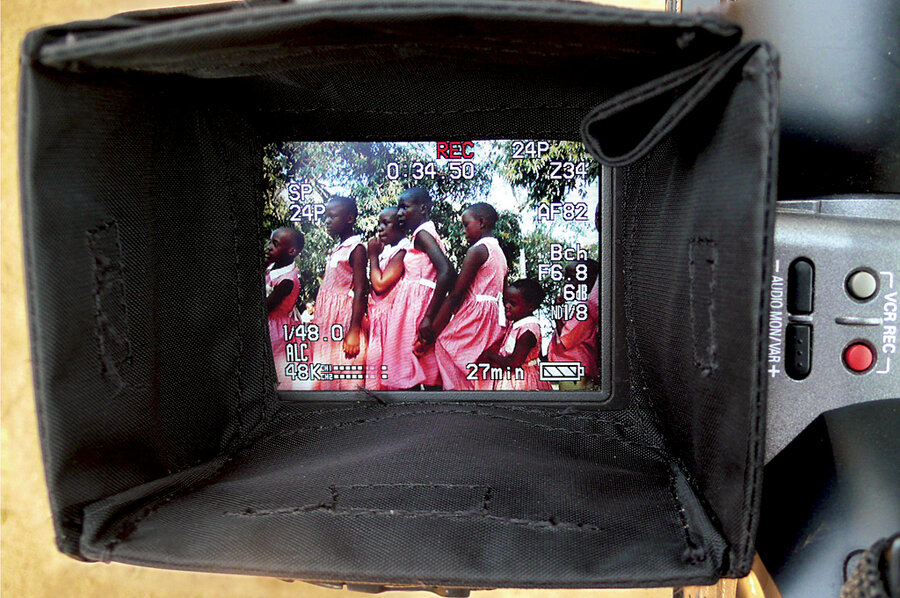Where Are You Taking Me?: movie review
Loading...
The marvelous documentary "Where Are You Taking Me?" was originally commissioned by Rotterdam's international film festival in conjunction with a series on African cinema. The Asian-American director, Kimi Takesue, who has an extensive career in documentaries and teaches film at Syracuse University, had never traveled to Africa. Along with 11 other international filmmakers, she and local African filmmakers were given no-strings commissions to make pieces for the festival. It sounds like a documentarian's dream, and from the look of the film, that's just what it was.
As Takesue has written: "I was particularly excited to participate in this project because my film work often deals with various kinds of cross-cultural encounters. I am interested in the process of 'looking' cross-culturally, and the interplay between the observer and the observed."
This may make the movie sound like some sort of ethnographic field trip, but it's far more lyrical than that. What the film is really about, as Takesue has said elsewhere, is "finding poetic moments in the everyday." The film has no driving agenda, no overbearing story arc.
Since the movie was shot in Uganda in the aftermath of its brutal civil wars, her approach, which dispenses with voice-over narration and even subtitles, may at first seem unconscionably arty. But I think she is right to work in this way. The film doesn't dispense with the horrors of the wars, it just mitigates the pain by finding in the people, the countryside, a revivifying beauty. The movie is both a representation of and a testament to healing.
Takesue's biracial background – she grew up in Hawaii and Massachusetts with an Asian-American father and Caucasian mother – no doubt contributes to her sensitivity to those "cross-cultural encounters." But she has a principled reticence when it comes to recording the Ugandans. She often lets her camera, at a discrete distance from its subject, simply register the human activity in its sights. The film's opening shot, for example, of a busy street corner in Kampala, is a microcosm of Ugandan city life, with motorbikers, women toting children, businessmen, beggars. By holding the shot, as she so often does in this film, Takesue is encouraging audiences to take a deep, long look at things they might otherwise miss.
This tactic, of course, only works if there is something worth looking at in the first place. Fortunately, the Uganda of this film is almost brazenly photogenic, and no more so than with the faces of the people themselves. Takesue has a wonderful eye for human portraiture, and for landscape portraiture, that is arresting without being static. She captures, as she intended, the lyricism of the everyday.
We are taken seemingly everywhere in the country, from Kampala to rural villages. We see a high-society wedding, with the bride and groom as crisply fashioned as figures atop a wedding cake; we observe a women's weight lifting competition held in the banquet room of a fancy hotel. In another sequence, a video VJ does live translations of Bruce Lee films in the local Lugandan language to a roomful of sleepyheaded kids. Boxers at a makeshift outdoor gym spar furiously in rhythmic pirouettes. We visit a movie set where what looks like a pulp action film is being shot. (Later on we see snippets from such a film inside a darkened theater.)
An impromptu break dancing competition turns into a joyful whirligig, especially when, to the onlookers' delight, a little girl wanders into the circle to try out moves. In the marketplaces, where the wares include colored fabrics of almost incandescent brightness, Takesue, who is always off camera, registers the curiosity and wariness her presence elicits from the vendors. A few people duck the camera altogether; others stare stonily into it or embrace it with wide smiles. They surely feel, and rightly so, that they are not zoo specimens, and Takesue is careful to respect their sympathies. And yet, in the end, she gets what she wants, even from those who turn away from her. The turning away, she seems to say, is part of the story, too.
One group that does not turn away are the children. In the second half of the film she concentrates on Hope North School, a refuge for children, some diagnosed with AIDS, many of them former child soldiers forced to commit unspeakable atrocities. These orphans and castoffs are rehabilitated here. They are given the gift of rediscovering human connections in peacetime. This is one part of the film that could have used a bit more context, but we get the message anyway. We get it not only in the rompy scenes with young kids mugging for the camera but also in the shot of a stricken-looking older boy who talks about how he dreams of guns and asks Takesue, "Why are you taking my story to USA New York?"
If he were to see this film, he would know why. Grade: A (Unrated)





